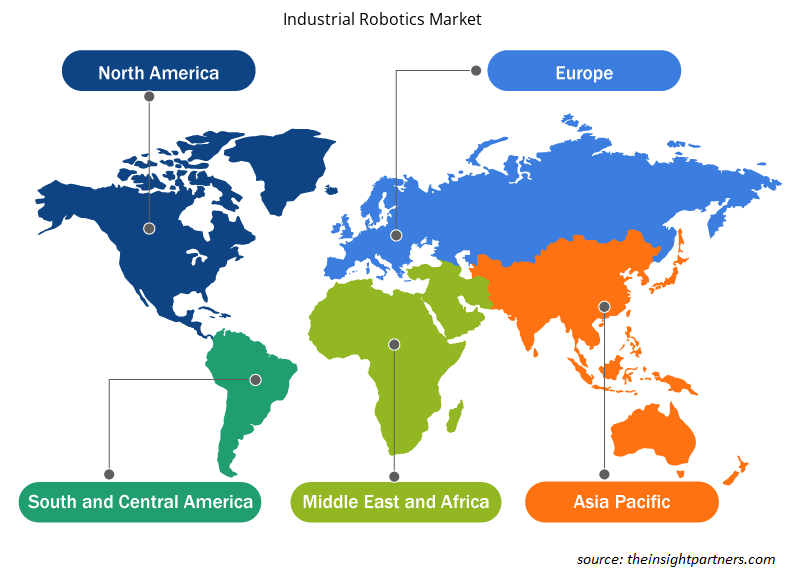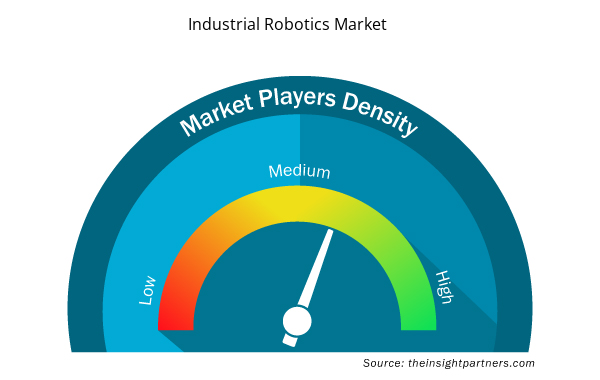産業用ロボットの市場規模は、2022年の148億6,000万米ドルから2030年には304億7,000万米ドルに達すると予測されています。市場は2022年から2030年の間に9.39%のCAGRを記録すると予想されています。5Gテクノロジーとエッジコンピューティングに対する需要の高まりは、今後も市場の主要なトレンドであり続けると思われます。
産業用ロボット市場分析
インダストリー4.0コンセプトの進化と、業務効率を高めるための協働ロボットの需要の高まりが市場を牽引しています。製造、倉庫、物流業界での自動化の需要の高まりにより、市場は予測期間中に成長すると予想されています。さらに、ロボット工学における人工知能技術の統合により、市場に有利な機会が生まれています。
産業用ロボット市場の概要
産業用ロボットは、工業製品の製造においてさまざまな機能や操作を実行できるセンサーと制御機能を備えたロボット アームと定義できます。ロボットは、繰り返し作業を周期的に実行するようにプログラムされています。これらのロボットは、生産に関わる人的要素を大幅に削減すると同時に、処理速度、品質、生産能力を向上させます。ロボットの最も重要なコンポーネントは、関節と接続部で構成されるアームであることは間違いありません。ロボット アームの最も重要なコンポーネントは、アーム先端ツール (EOAT) です。ロボット アームは、マーキング、切断、溶接、穴あけ、塗装、清掃など、さまざまな作業を行います。
要件に合わせてレポートをカスタマイズする
このレポートの一部、国レベルの分析、Excelデータパックなど、あらゆるレポートを無料でカスタマイズできます。また、スタートアップや大学向けのお得なオファーや割引もご利用いただけます。
- このレポートの主要な市場動向を入手してください。この無料サンプルには、市場動向から見積もりや予測に至るまでのデータ分析が含まれます。
産業用ロボット市場の推進要因と機会
市場に有利なインダストリー4.0コンセプトの進化
インダストリー 4.0 とは、ロボット工学、自動化、モノのインターネット (IoT) の進歩によって推進されている現在の産業革命を指します。産業用ロットと人工知能の台頭は、ロボット工学に大きな影響を与える可能性があります。インダストリー 4.0 テクノロジにより、新しいメンテナンス戦略、自律型ロボット、および協働型ロボット技術が可能になります。新しいメンテナンス戦略と人工知能は、ロボットに大きな影響を与えると予想されています。産業用ロボットとインダストリー 4.0 テクノロジは、機械管理を改善し、以前は手動で行われていたタスクを自動化することで、今後数年間でビジネスを変える可能性があり、産業用ロボット市場の成長を促進すると予測されています。IoT). The rise of industrial lot and
ロボット工学における人工知能技術の統合
AI は、ロボット工学と自動化の分野で目覚ましい進歩を遂げています。ロボット工学における AI が進化し、開花するにつれ、多くの業界がこれらの最先端技術を活用しています。たとえば、高度なデータ収集と分析を促進するインテリジェントな自動化プロセスの実装、企業、サービス、メーカーによるデータ駆動型の意思決定の実現、作業プロセスとタスクの円滑化のための自己学習型ロボットの実装などです。AI ベースの自己学習型ロボットの採用により、予測期間中に市場にチャンスが生まれることが期待されています。
産業用ロボット市場レポートのセグメンテーション分析
産業用ロボット市場分析の導出に貢献した主要なセグメントは、タイプ、機能、および業界です。
- タイプに基づいて、産業用ロボット市場は、多関節型、直交型、SCARA、協調型、並列型、その他に分類されます。多関節型セグメントは、2022年に大きな市場シェアを占めました。cartesian, SCARA, collaborative, parallel, and others. The articulated segment held a larger market share in 2022.
- 機能別に見ると、市場ははんだ付けと溶接、マテリアルハンドリング、組み立てと分解、塗装とディスペンシング、フライス加工、切断と加工に分類されています。マテリアルハンドリング部門は2022年に大きな市場シェアを占めました。
- 業界別に見ると、市場は自動車、医療・医薬品、電気・電子、ゴム・プラスチック、金属・機械、食品・農業に分かれており、2022年には食品・農業部門が大きな市場シェアを占めました。
産業用ロボット市場シェアの地域別分析
産業用ロボット市場レポートの地理的範囲は、主に北米、アジア太平洋、ヨーロッパ、中東およびアフリカ、南米および中米の 5 つの地域に分かれています。
ヨーロッパの市場は、産業用ロボットの需要増加により、予測期間中に拡大すると予測されています。産業用ロボットの設置は、2020年と比較して2021年に33%増加しました。2021年の産業用ロボットの使用は、2020年と比較して、電子業界で22%、自動車業界で57%、金属および機械事業で29%増加しました。IFRによると、2023年1月、中国、日本、韓国は、年間産業用ロボットの設置に関して最も先進的な上位5か国に入り、中国の産業用ロボット市場は最も高い発展を遂げています。
産業用ロボット市場の地域別洞察
予測期間を通じて産業用ロボット市場に影響を与える地域的な傾向と要因は、Insight Partners のアナリストによって徹底的に説明されています。このセクションでは、北米、ヨーロッパ、アジア太平洋、中東およびアフリカ、南米および中米にわたる産業用ロボット市場のセグメントと地理についても説明します。

- 産業用ロボット市場の地域別データを入手
産業用ロボット市場レポートの範囲
| レポート属性 | 詳細 |
|---|---|
| 2022年の市場規模 | 148.6億米ドル |
| 2030年までの市場規模 | 304.7億米ドル |
| 世界のCAGR(2022年 - 2030年) | 9.39% |
| 履歴データ | 2020-2021 |
| 予測期間 | 2023-2030 |
| 対象セグメント | タイプ別
|
| 対象地域と国 | 北米
|
| 市場リーダーと主要企業プロフィール |
|
市場プレーヤーの密度:ビジネスダイナミクスへの影響を理解する
産業用ロボット市場は、消費者の嗜好の変化、技術の進歩、製品の利点に対する認識の高まりなどの要因により、エンドユーザーの需要が高まり、急速に成長しています。需要が高まるにつれて、企業は提供を拡大し、消費者のニーズを満たすために革新し、新たなトレンドを活用し、市場の成長をさらに促進しています。
市場プレーヤー密度とは、特定の市場または業界内で活動している企業または会社の分布を指します。これは、特定の市場スペースに、その市場規模または総市場価値に対してどれだけの競合相手 (市場プレーヤー) が存在するかを示します。
産業用ロボット市場で事業を展開している主要企業は次のとおりです。
- ABB株式会社
- 安川電機株式会社
- 不二越株式会社
- 富士ロボティクス
- クーカAG
- ユニバーサルロボティクスAS
免責事項:上記の企業は、特定の順序でランク付けされていません。

- 産業用ロボット市場のトップキープレーヤーの概要を入手
産業用ロボット市場のニュースと最近の動向
産業用ロボット市場は、主要な企業出版物、協会データ、データベースなどの一次調査と二次調査を経て定性的および定量的データを収集することで評価されます。産業用ロボット市場の動向のいくつかを以下に示します。
- ABB Ltd は、ミシガン州オーバーンヒルズにある現在のロボット本社と生産工場の拡張工事を開始し、最も重要な顧客市場の 1 つである米国への取り組みを再確認しました。このプロジェクトは 2023 年 11 月に完了し、費用は 2,000 万ドルと見込まれています。この拡張により、ミシガン ビジネス開発プログラムからの 45 万ドルの成果ベースの助成金によって、この地域に 72 の高度なスキルを必要とする新しい雇用が創出されます。(出典: ABB Ltd、会社 Web サイト、2023 年 3 月)
産業用ロボット市場レポートの対象範囲と成果物
「産業用ロボット市場の規模と予測(2020〜2030年)」レポートでは、以下の分野をカバーする市場の詳細な分析を提供しています。
- 対象範囲に含まれるすべての主要市場セグメントについて、世界、地域、国レベルでの産業用ロボット市場規模と予測
- 産業用ロボット市場の動向、推進要因、制約、主要な機会などの市場動向
- 詳細なPEST/ポーターの5つの力とSWOT分析
- 主要な市場動向、世界および地域の枠組み、主要プレーヤー、規制、最近の市場動向を網羅した産業用ロボット市場分析
- 産業用ロボット市場の市場集中、ヒートマップ分析、主要プレーヤー、最近の動向を網羅した業界の状況と競争分析
- 詳細な企業プロフィール
- 過去2年間の分析、基準年、CAGRによる予測(7年間)
- PEST分析とSWOT分析
- 市場規模価値/数量 - 世界、地域、国
- 業界と競争環境
- Excel データセット


- Investor ESG Software Market
- Aquaculture Market
- Equipment Rental Software Market
- Medical Second Opinion Market
- Third Party Logistics Market
- Single-Use Negative Pressure Wound Therapy Devices Market
- Hydrogen Storage Alloys Market
- Workwear Market
- Health Economics and Outcome Research (HEOR) Services Market
- Intradermal Injection Market

Report Coverage
Revenue forecast, Company Analysis, Industry landscape, Growth factors, and Trends

Segment Covered
This text is related
to segments covered.

Regional Scope
North America, Europe, Asia Pacific, Middle East & Africa, South & Central America

Country Scope
This text is related
to country scope.
よくある質問
The rising demand for 5G technology and edge computing to play a significant role in the global industrial robotics market in the coming years.
The key players holding majority shares in the global industrial robotics market are ABB Ltd, Yaskawa Electric Corporation, Nachi-Fujikoshi Corp, Fuji Robotics, KUKA AG, Universal Robotics AS, Honeybee Robotics, COMAU SPA, and Clearpath Robotics Inc.
The global industrial robotics market is expected to reach US$ 30.47 billion by 2030.
The global industrial robotics market is estimated to register a CAGR of 9.39% during the forecast period 2022–2030.
Asia Pacific dominated the industrial robotics market in 2022.
The evolution of the Industry 4.0 Concept and the growing demand for collaborative robots for enhancing operational efficiency are the major factors that propel the global industrial robotics market.
Trends and growth analysis reports related to Electronics and Semiconductor : READ MORE..
The List of Companies - Industrial Robotics Market
- ABB Ltd
- Yaskawa Electric Corporation
- Nachi-Fujikoshi Corp
- Fuji Robotics
- KUKA AG
- Universal Robotics AS
- Honeybee Robotics
- COMAU SPA
- Clearpath Robotics Inc
- Staubli International AG
The Insight Partners performs research in 4 major stages: Data Collection & Secondary Research, Primary Research, Data Analysis and Data Triangulation & Final Review.
- Data Collection and Secondary Research:
As a market research and consulting firm operating from a decade, we have published and advised several client across the globe. First step for any study will start with an assessment of currently available data and insights from existing reports. Further, historical and current market information is collected from Investor Presentations, Annual Reports, SEC Filings, etc., and other information related to company’s performance and market positioning are gathered from Paid Databases (Factiva, Hoovers, and Reuters) and various other publications available in public domain.
Several associations trade associates, technical forums, institutes, societies and organization are accessed to gain technical as well as market related insights through their publications such as research papers, blogs and press releases related to the studies are referred to get cues about the market. Further, white papers, journals, magazines, and other news articles published in last 3 years are scrutinized and analyzed to understand the current market trends.
- Primary Research:
The primarily interview analysis comprise of data obtained from industry participants interview and answers to survey questions gathered by in-house primary team.
For primary research, interviews are conducted with industry experts/CEOs/Marketing Managers/VPs/Subject Matter Experts from both demand and supply side to get a 360-degree view of the market. The primary team conducts several interviews based on the complexity of the markets to understand the various market trends and dynamics which makes research more credible and precise.
A typical research interview fulfils the following functions:
- Provides first-hand information on the market size, market trends, growth trends, competitive landscape, and outlook
- Validates and strengthens in-house secondary research findings
- Develops the analysis team’s expertise and market understanding
Primary research involves email interactions and telephone interviews for each market, category, segment, and sub-segment across geographies. The participants who typically take part in such a process include, but are not limited to:
- Industry participants: VPs, business development managers, market intelligence managers and national sales managers
- Outside experts: Valuation experts, research analysts and key opinion leaders specializing in the electronics and semiconductor industry.
Below is the breakup of our primary respondents by company, designation, and region:

Once we receive the confirmation from primary research sources or primary respondents, we finalize the base year market estimation and forecast the data as per the macroeconomic and microeconomic factors assessed during data collection.
- Data Analysis:
Once data is validated through both secondary as well as primary respondents, we finalize the market estimations by hypothesis formulation and factor analysis at regional and country level.
- Macro-Economic Factor Analysis:
We analyse macroeconomic indicators such the gross domestic product (GDP), increase in the demand for goods and services across industries, technological advancement, regional economic growth, governmental policies, the influence of COVID-19, PEST analysis, and other aspects. This analysis aids in setting benchmarks for various nations/regions and approximating market splits. Additionally, the general trend of the aforementioned components aid in determining the market's development possibilities.
- Country Level Data:
Various factors that are especially aligned to the country are taken into account to determine the market size for a certain area and country, including the presence of vendors, such as headquarters and offices, the country's GDP, demand patterns, and industry growth. To comprehend the market dynamics for the nation, a number of growth variables, inhibitors, application areas, and current market trends are researched. The aforementioned elements aid in determining the country's overall market's growth potential.
- Company Profile:
The “Table of Contents” is formulated by listing and analyzing more than 25 - 30 companies operating in the market ecosystem across geographies. However, we profile only 10 companies as a standard practice in our syndicate reports. These 10 companies comprise leading, emerging, and regional players. Nonetheless, our analysis is not restricted to the 10 listed companies, we also analyze other companies present in the market to develop a holistic view and understand the prevailing trends. The “Company Profiles” section in the report covers key facts, business description, products & services, financial information, SWOT analysis, and key developments. The financial information presented is extracted from the annual reports and official documents of the publicly listed companies. Upon collecting the information for the sections of respective companies, we verify them via various primary sources and then compile the data in respective company profiles. The company level information helps us in deriving the base number as well as in forecasting the market size.
- Developing Base Number:
Aggregation of sales statistics (2020-2022) and macro-economic factor, and other secondary and primary research insights are utilized to arrive at base number and related market shares for 2022. The data gaps are identified in this step and relevant market data is analyzed, collected from paid primary interviews or databases. On finalizing the base year market size, forecasts are developed on the basis of macro-economic, industry and market growth factors and company level analysis.
- Data Triangulation and Final Review:
The market findings and base year market size calculations are validated from supply as well as demand side. Demand side validations are based on macro-economic factor analysis and benchmarks for respective regions and countries. In case of supply side validations, revenues of major companies are estimated (in case not available) based on industry benchmark, approximate number of employees, product portfolio, and primary interviews revenues are gathered. Further revenue from target product/service segment is assessed to avoid overshooting of market statistics. In case of heavy deviations between supply and demand side values, all thes steps are repeated to achieve synchronization.
We follow an iterative model, wherein we share our research findings with Subject Matter Experts (SME’s) and Key Opinion Leaders (KOLs) until consensus view of the market is not formulated – this model negates any drastic deviation in the opinions of experts. Only validated and universally acceptable research findings are quoted in our reports.
We have important check points that we use to validate our research findings – which we call – data triangulation, where we validate the information, we generate from secondary sources with primary interviews and then we re-validate with our internal data bases and Subject matter experts. This comprehensive model enables us to deliver high quality, reliable data in shortest possible time.


 このレポートの無料サンプルを入手する
このレポートの無料サンプルを入手する